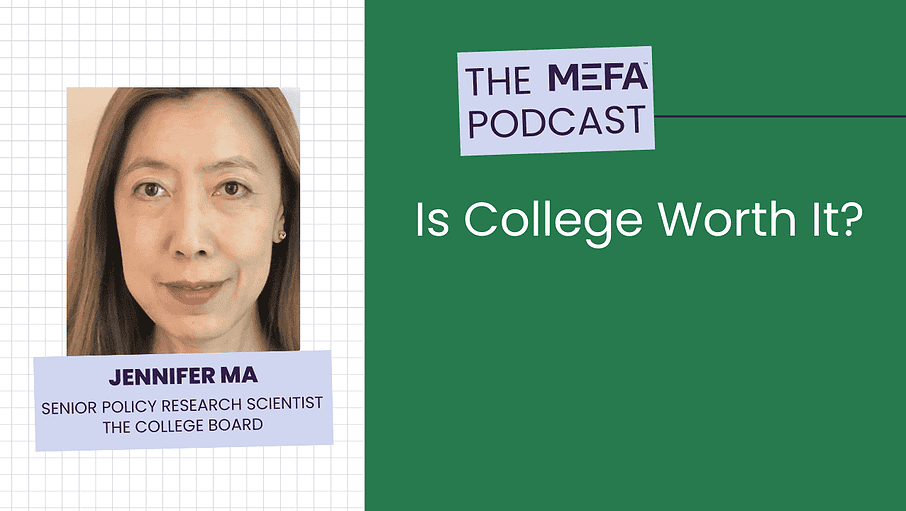

Resources Mentioned in this Episode
Jonathan Hughes: Hi, everyone. Welcome back to the MEFA podcast. I’m Jonathan Hughes.
Julie Shields-Rutyna: And I’m Julie Shields-Rutyna
Jonathan Hughes: And we have a great show for today. And I’ll tell you why. Now you’ve heard of the College Board. We’ve mentioned them many times on this podcast, and they’re a really important group that administers the SATs®, the AP® program, and also the CSS Profile®, which many of you have filed or will need to file for financial aid depending on where your students are going.
So they’re a really big, important group. They’re a big deal, right Julie? Well, they also do a lot of research and they do publications on things like trends in financial aid and college pricing, you know, national averages of how much college costs by type and how much financial aid students receive.
So this material gets used all the time by us in our presentations and our trainings. There’s just so much good stuff in those publications that if you really want to understand the state of higher education in the U.S, there’s just such great resources. So one of the chief architects of those reports, Jennifer Ma, who is the Senior Policy Research Scientist at the College Board, is our guests on the show today. And she’s going to discuss a publication called Education Pays. And this publication appears once every three years and examines the value of a college degree among other things.
And I love this report because it really cuts to the quick about a question that students and parents, who are maybe understandably anxious about the cost of college, have, and that is, is college worth it. So this is going to talk all about whether or not college is worth it and the value of a college education. It’s going to talk about a lot of things. So, if you have that question on your mind, anybody that really wants to understand the value of a college education should listen to our talk because it’s great.
But before we do that, we have a few things we want to discuss first, right Julie?
Julie Shields-Rutyna: We do. And, let’s just talk a little bit about the questions families are asking of MEFA these days. It seems that parents are now starting to think about the college bills that will be arriving in the summer.
And so they’re trying to get their financing together, making sure there’ll be able to make payments. And so they’re asking us a lot about loans, and we could probably talk for the full hour about all the different loan questions. But one of the most common questions we get is about interest rates for the upcoming year.
And to that end, we have some news that broke at the end of May regarding federal student loan interest rates, not interest rates, which we will also mention, but the federal student loan interest rates.
Jonathan Hughes: Okay now can you tell everybody exactly which loans we’re talking about?
Julie Shields-Rutyna: Yes. So if, if you filed the FAFSA to apply for financial aid, then you probably received some federal direct student loans in your financial aid offer. So those loans are put directly in the financial aid offer for the student and they can be partly subsidized and some un-subsidized. And that’s the differentiation is whether the government is paying the interest while the student is in school or not.
And these loans have some special benefits. They’re just in the student’s name. They have low interest rates. They have that possibility of a subsidy and they have a lot of repayment options. So, they really are the best loans out there for the students to take. Now in the coming year, 21, 22, the interest rate on the federal direct student loans for undergraduate students will be 3.7, 3, 4%. And the interest rate on federal direct student loans for graduate students for 2122 will be 5.284.
Jonathan Hughes: And so that is an increase from the past year. Is that correct?
Julie Shields-Rutyna: It is a slight increase, and that interest rate changes every year, but you’ll always pay back this loan at that rate. Fixed
Jonathan Hughes: Good point. Good point. So even though it’s an increase from last year though, last year the rates were very low, right?
Julie Shields-Rutyna: Exactly. Exactly. So this is still, these are still very low interest rates.
Jonathan Hughes: Okay. So, those are the student loans, but there are federal parent loans as well, right?
Julie Shields-Rutyna: Yes. So there is a parent loan program and it’s called the PLUS program parent loan for undergraduate students. So that is not financial aid or part of the financial aid offer. That is a loan for parents that the parent would apply for and have to be approved for based on credit and all of that.
So that’s one option that a parent could look into as well as other options like the MEFA loan, like any loans through banks, all of that. And so the interest rate on the federal direct parent loan, in the coming year 21, 22 will be 6.284. And graduate students can also borrow what’s called a federal direct grad plus loan.
So that’s another additional loan for students. And that interest rate will be 6.284.
Jonathan Hughes: Okay. Okay. So you mentioned MEFA loans as well. So what about MEFA loan rates for next year?
Julie Shields-Rutyna: MEFA is going to set their loans any day now. So we know sometime in June, we will know what the new rate MEFA loans is for the upcoming year. And, just say that MEFA traditionally has a very competitive low rate for loans. So definitely stay tuned for what the loan rate will be for the coming year. And you know, for MEFA loans, you can apply now for the upcoming year and you’ll receive the rate that you are approved for.
And if you apply and are approved, now the rates go up, you’ll have the lower rate. And if they go down, you can reapply. So feel free to apply for your MEFA loan at any time.
Jonathan Hughes: That is great. Thank you so much, Julie. Now we’re going to head over to the MEFA mailbag, and these are questions as always that have come in from customers over the past two weeks and answered by our college guidance experts.
So if you have any questions, please do reach out to us at [email protected], or you can call us at 1-800-449-MEFA. You can also reach us on social media, on Facebook or on LinkedIn and YouTube or on Twitter @MEFAtweets, that’s our Twitter handle. And I thought for this question, we would depart from what we usually do a little bit and pick a question that came in during a webinar.
So Drew Carter and Julie conducted a webinar last night on college admissions, specifically ways juniors can strengthen their applications. This is the one that Drew was a guest on this podcast to promote a few weeks ago. And he’s great. And Julie’s great. So I can only imagine it went as well as the podcast went, if not better.
This question comes to us, I hope I’m saying this perfectly, from Eco and who asks us about letters of recommendation. They write, does it matter what subject the teacher who was writing the recommendation teaches, for example, math or English, et cetera. So, Julie, how did Drew answer that question?
Julie Shields-Rutyna: Yes. And I will say we had a terrific webinar last night.
So you can find that on the MEFA website, if you want to hear all of the questions, but this was a common one. We had a number of families asking a variation of this question. So this is what Drew said, that unless a student is applying to say a music conservatory school or something that’s very specific, in general, the student wants to have recommendations from teachers of one of the five major subjects. So English, math, science, history, or foreign language. That’s in general, the subject matter that would fit well for applying to college, from a teacher in one of those subjects.
So that’s in general how to think about that. But you should also talk to your school counselor because let’s say you’re applying into an engineering program. Maybe an engineering program at a certain college likes to see science recommendations or math recommendations more. So it’s good to involve your school counselor and ask about that choice.
And lastly, one of the most important things about the person who was writing your recommendation is that it’s someone who knows you well and can really speak specifically about you and who you are as a student and your qualities. So keep that in mind as well. But I think all of those three sort of should give someone a good idea of that question.
Jonathan Hughes: That was great. And I have to know, did you also add at any point during the presentation last night to write a thank you note?
Julie Shields-Rutyna: Yes, he did. He definitely stresses that thanking the teachers is very, very important.
Jonathan Hughes: Okay. Well, thank you so much. Now remember, if you have any questions, you can call us up at 1-800-449-MEFA.
I’ll say it again. Or you can email us at [email protected]. We have a bunch of college guidance experts waiting to answer your questions. So I hope you take advantage of that. Now let’s go to my talk with Jennifer Ma, the Senior Policy Research Scientist at the College Board.
Many of you may know the College Board as the organization that oversees the SATs and the AP program, as well as the CSS Profile. They’re also well known in the industry for their research publications. And here to talk about one that I’ve cited many times called Education Pays is one of the authors of that report, Jennifer Ma. She’s the Senior Policy Research Scientist at the College Board. Jennifer, thank you for being on the show. We’re all really excited that you came
Jennifer Ma: Well thank you for having me, Jonathan. Happy to be here.
Jonathan Hughes: Thanks. So let’s just get right to it. The question that we hear time and again is, is college worth it.
And we’ve used information from this publication in the past to speak to those questions. So generally at a high level, can we talk about what the report says?
Jennifer Ma: Definitely. So in this report, we document the many benefits of obtaining a college degree. So these benefits include earnings, employment, social mobility, health and civic engagement. So earnings of course are the most often listed as the number one reason that students say, why did he want to go to college? So this is not surprising because the majority of students pay at least a portion of their college expenses. And so as the price of attending college continues to rise, it’s not surprising that school students and families are asking whether college is worth it.
And the answer to question is yes. So we use the latest data from the census bureau. We look at median earnings of full-time workers with different college, different education levels. The reason we use full-time earnings, just full-time workers, is just so that we can look at the earnings compared and on the apples to apples basis.
So the latest with data we have, which is 2018, we saw that the median earnings of those whose highest education was a college degree, a four year bachelor’s degree. They made nearly $25,000 more than high school graduates. And people who had advanced degree, they earned even more.
So the earning is definitely much higher for people with more education.
Jonathan Hughes: One of the issues that we often see or hear in the media or on political campaign trails, and it’s something that comes up when I talk to students too, is the concern about the rising level of student debt. And so some might argue that it’s not worth taking on debt to go to college.
I was wondering if you could speak to that.
Jennifer Ma: So the issue of student debt is a super important one, and we know that the current administration is contemplating forgiving some amount of student loans. So this issue is also very nuanced. The number we probably often hear about is the aggregate outstanding debt of $1.6 trillion.
So what that means is overall, if you look at everyone in this country and add up all the student debt that they owe, that number is 1.6 trillion. It’s a very large number and it’s really assured thing, but it’s also important to know that one of the reasons this number has been rising is because there’s simply more people going to college.
And in our Trends in Student Aid Report, which is published every year, we look at student debt. Both accurate at the aggregate level. So we’ll look at overall how much debt is owed, but we also look at student debt at the student level. So we look at how much each student, and for many students, is student level numbers, right?
Uh, more properly, more appropriate because those numbers are more relevant to themselves. So there are lots of analysis on student debt in that report, and I would like to mention just four key points on this topic. Number one is that students who complete a college degree or credential, they tend to fare much better in repaying their student loans than non completers.
So here completion is really key in the success of pay in dollars. The second point is that the average amount borrowed by bachelor’s degree recipients increased dramatically during and right after the great recession, the average debt levels at graduation actually have been stable in recent years.
Number three is that many students with high loan balances are those who actually have attended graduate school and borrow to finance that graduate school education. And finally related to number three, borrowers with high loan balances, they owe a big portion of the outstanding debt.
So just to give you a sense, 10% of the federal student loan borrowers, they actually hold nearly half of all the outstanding debt. And in terms of whether students and families should take on that to go to pay for college. I would say that excessive borrowing should always be avoided, but we also know that each students and families, the current circumstance is different.
So it’s really a lot of time is a personal choice. However, borrowing a reasonable amount to finance a college education is a sound investment in our Education Pays Report. We calculate the lifetime earnings at different education levels, and not only do that, we also take into account that students, they have to pay for college, and sometimes they had to borrow.
We also take into account the fact that when they’re in school, they can’t work full time. So there’s this forgot earnings piece. And our calculations show that even taking all these factors into account at age 33, the average bachelor’s degree recipient will have recovered the cost of forgone, forgone wages as well as college tuition.
So to go back to your initial question, so college is worth it, even though sometimes it means the students had to borrow some money to pay for it.
Jonathan Hughes: That’s fantastic. I’m really glad you’re here to talk about these and to make these points, especially in this to say in a strict financial sense that yes, college is worth.
Then by age 33, you know, the average student has recouped their costs and their bachelor’s degree. That’s a really interesting data point that I wasn’t aware of. So, as I said, I’m glad you’re here. Now I’d like to turn to some of the other topics covered in the report.
First, the report shows a clear negative relationship between unemployment rate and educational levels. So that is those who have a higher level of educational attainment have lower unemployment rates. Does that hold true for new college graduates?
Jennifer Ma: Yes, it does. So over time, data shows that when we look at all working adults, the unemployment rate of four years, actually just all adults, because some people who are in employment, they’re not working.
So the unemployment rate of four year college graduates having consistently about half of those of high school graduates. So this relationship has been remarkably stable. Even we know that employment rates tend to fluctuate with the economy. So even if you look at last year during a pandemic in the second quarter, when the economy shut down, the overall unemployment was over 10% and even that, so with college graduates, their employment was also about half the employment rate of high school graduates around that time.
And when we look at employment rates across different age groups, the pattern is the same. So it’s always the case that folks with more education, they have lower employment rates. In fact, I do want to mention that the among the younger age groups, the high school graduates the employment gap between the high school graduates and college graduates.
It’s much larger than the gap for older age groups.
Jonathan Hughes: Hmm. That’s interesting. Yeah. That’s one of the things that was interesting to me and in reading this report for the first time was some of the other benefits. Now we talked about the financial benefits that come from educational attainment, but can you talk about some of the other sort of societal benefits, not related to earnings, but related to higher education?
Jennifer Ma: Sure. So we know that more education is associated with higher earnings, lower unemployment, more social mobility. So we consider all of these as personal benefits because people who get their degree, they tend to receive these benefits.
But in addition to these, we also see the society as a whole benefits from having a more educated population. So for example, let’s take a look at voting. We have the latest data from the census bureau presidential elections is for 2016. So the 2020 data, not the 2020 data, it’s not out yet. In the 2016 election, 76% of us citizens with a bachelor’s degree voted and for high school graduates, that number is 52%.
So when we look at a breakdown, the boat is raised by age, we also see that within each age group bachelor’s degree recipients, they’re more likely to vote than other people who receive less education. And in addition to voting, we also look at volunteering. And we see that college educated adults are more likely to volunteer than others.
Our latest data shows that 42% of the adults who have a bachelor’s degree volunteered and compared to just 19% of high school graduates, you think about this year. So college graduates are more twice as likely to volunteer as high school graduates.
Jonathan Hughes: No, since that moves us into a kind of civic area.
I was wondering if we could talk about, um, equity and talk about, I’m also interested in the breakdown of enrollment data, enrolling in college in terms of rates raised in ethnicity and how the historical gaps in those arenas are closing, as well as socioeconomic status and gender, those gaps as well.
What picture does the data paint there?
Jennifer Ma: So we have seen some progress in closing the enrollment gap across different groups. And if you look at data, the immediate college enrollment rates, so by immediate, I mean we’re looking at recent high school graduates and what percent of those graduates move on to college within 12 months of high school graduation.
So we see that immediate college enrollment rates actually increased in the 1980s and 1990s across different racial, ethnic groups. However, enrollment rates for black and white students have mostly stayed flat in the last two decades. And one group that saw large increases in enrollment rates in the recent two decades is Hispanic students.
So which means that if you look at the most recent enrollment data in 2018 that we have in the report. We still see gaps in enrollment rates, across different groups. We see that 60% of black high school graduate enrolled in college within 12 months of high school graduation and for Hispanic students that’s 66% and for white students is 70% and for Asian students is 83%. So there are still some significant gaps that exist across different groups. And if we look at enrollment rates by gender, and we saw that over in the late 1970s, about 50% of male students, as well as HIPAA, 80% of female students enrolled in college right after high school.
But over time, what’s really interesting is enrollment rates of female students actually have increased at a much faster rate than male students and the latest numbers show that 72% of female students and 65% of male students enrolled in college right after high school.
Jonathan Hughes: And, and so what does that tell us then about the overall educational attainment of these different groups?
Jennifer Ma: Yes. So the education attainment actually measures the share of population with different education levels. So we see, oftentimes we’ll look at young adults to see what share of that population has a four year degree, two year degree, and so on. So what we see here is actually attainment college education that the payment has increased for all ratio, ethnic groups and over time there’s been a large increases in the percentage of population with a college degree. But similar to the enrollment story, there’s still gaps across different groups. So, among young adults, we are seeing that the share of white and Asian students who have a bachelor’s degree is about twice the share of black and Hispanic young adults who have a bachelor’s degree.
Jonathan Hughes: Can we talk about the history of the report itself, and how did it originate and how has it changed over the years?
Jennifer Ma: Sure. And this approach actually debuted in 2004 as a competitive piece to our annual Trends in College Pricing and Trends in Student Aid Reports.
And since this debuted it’s been updated and refined every three years. And the first one I worked on is the second edition, which was published in 2007. Over time, I would say that we have expanded the scope of the report. We try to incorporate a new analysis from new DAMA datasets. And in addition, we’re using more ways to analyze the data.
So for example, in addition to reporting immediate earnings, we now document variation in earnings by different characteristics. So it would look at different, we look at earnings by gender, race, ethnicity, occupation, college, major, and institutional sector. We also look at the distribution of earnings.
So for example, we know that the median, the higher the education level, the higher the earnings, but we also know that of course the median is not everyone. So there are always some people who don’t make, there’s going to be a small percentage of college graduates who don’t make as much as the median high school graduates.
So there’s always that piece of it. And we also use new datasets. So for example, starting with the 2016 edition, we have included labor market outcomes of students from specific majors and also the sectors that they went to. So these are from the Department of Education’s College Scorecard data, which also has been enhanced over time.
They’d be adding more information. If you haven’t looked at it, I encourage you to look at it. It has great information. Student debt, earnings, and also net price.
Jonathan Hughes: When there is a CSS conference, every year would always be, you know, I want to, I got to get to the new Trends in College Pricing and new Trends in Student Aid presentations to see the data. Education pay is the one we’re talking about here.
It comes out every three years. Correct. And so this particular report, then the most recent one was 2018, which was of course pre-COVID. So I’m not sure if there’s anything that we can say about the effect that the COVID pandemic may have. But we do have data going back to 1940 on certain things, and they didn’t know if there was anything that you could point to that could provide some perspective on the current situation.
Jennifer Ma: Sure. So when, clarification’s most recent report, as 2019, and it was actually officially released in January 2020. So just a few months before COVID hit and the thing that’s a really great question about what can we say about the impact of COVID, college enrollment retention, and just also higher education industry in general, from what have we have seen in the history.
And I will say that what’s really clear is that COVID is certainly an unprecedented event, is nothing that we’ve ever, nobody has ever seen. And the impact of COVID on college enrollment is also fairly dramatic. And we don’t have the full picture yet because oftentimes you see a delayed effect.
But we have seen some preliminary data from the National Student Clarion House. They have these several reports looking at year to year changes in total enrollment and generally, they’re seeing declines in undergraduate enrollment across different sectors. Of course, you know, some sectors are hit harder than others.
Some student population, students segments are hit harder by COVID than others. And I would say one big difference is that into great recession of 2008, we saw large increases in college enrollment, right after that, especially among part-time students in the public two year in the for-profit sector.
So we certainly are not seeing that. And of course COVID is also there’s this health aspect that complicates things. I would say COVID is likely to have a lasting impact and we [00:31:00] expect to see many research studies that address this topic in the future. And we’ll certainly learn more about how COVID will affect college enrollment and higher ed.
Jonathan Hughes: Well, I will look for those reports, of course, as I do with every report that you put out, I’m always interested to see them, as I said. So I want to thank you again for being on the show, Jennifer Ma and also, I can’t tell you how many times that I’ve gone back and referenced something in Trends in College Pricing or Education Pays for a presentation of ours, or for something that I’m putting together for families.
So, just want to say, I truly appreciate all the work that you do over at the College Board on the research front and thank you for being on. And hopefully you’ll come back on this show next year.
Jennifer Ma: Thanks for having me, Jonathan, I do want to say that, feel free to use our resources. We do have the PDF and reports online.
We had the Excel data. If you want to make your own graph, we also have PowerPoint files that have every single figure. And these reports are available online at researchthatcollegeboard.org/trends
Jonathan Hughes: Thank you very much. I know it from experience, but I will, as I said, link to these reports so that anybody can take a look at that if they wanted to see it. Once again, thank you so much.
Jennifer Ma: Thank you, Jonathan.
Jonathan Hughes: Well, that’s our show, everyone. Julie, as always, thank you for joining me. Now, remember, if you liked the show, please follow us on Spotify, Apple podcasts, or wherever you’re hearing this. And if you could do us an extra favor and give us a five-star rating where you’re able to do that, that would make us really, really happy.
So until next time, bye everybody.











